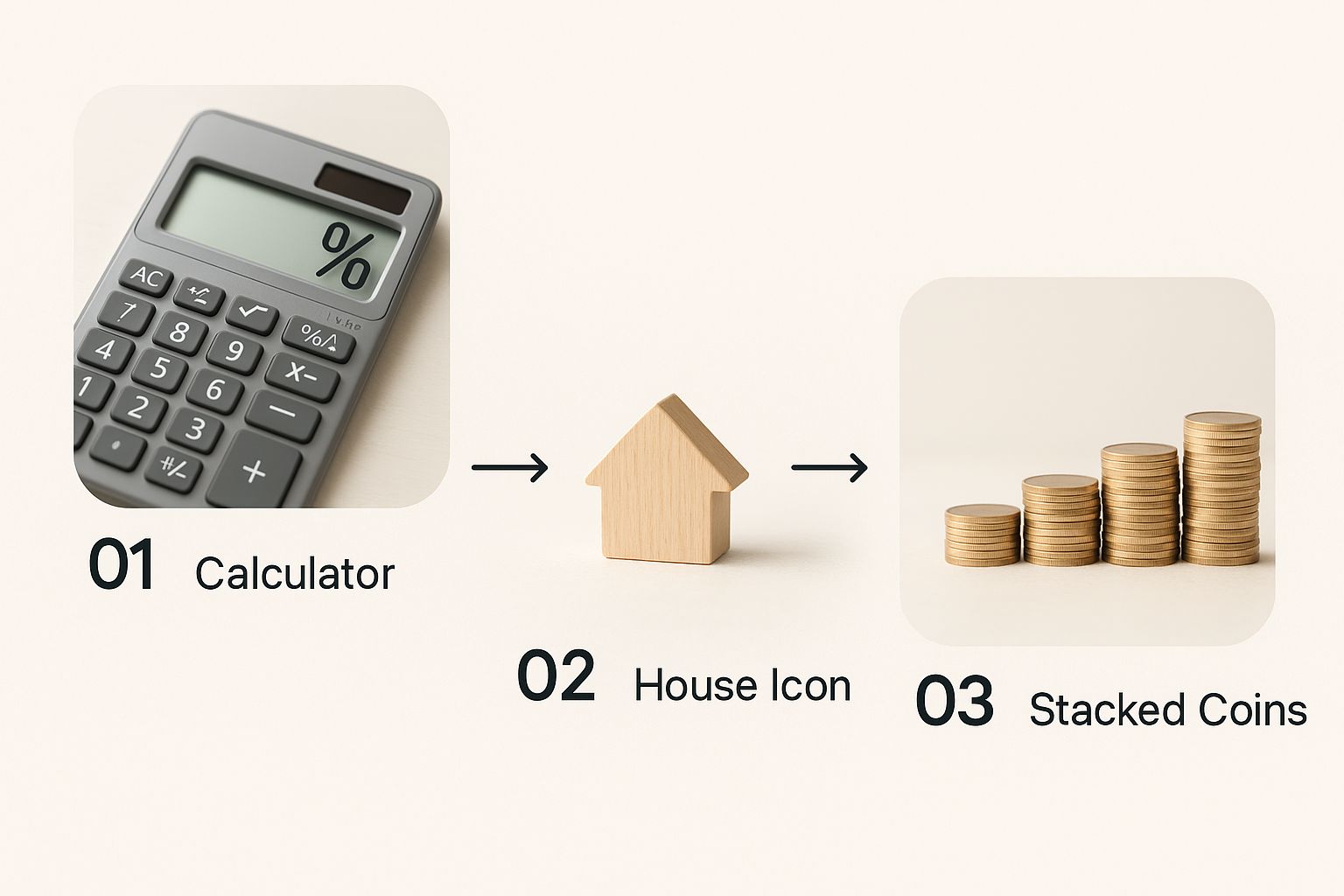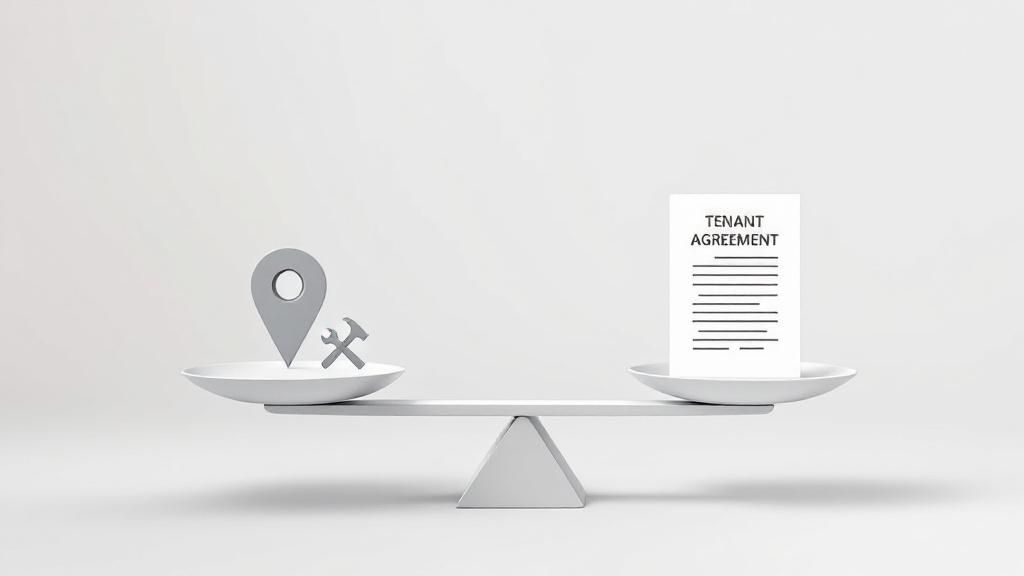How to Calculate Rental Yield: A San Diego Investor's Guide
- Mark Palmiere

- Oct 7
- 8 min read
TL;DR: Calculate Rental Yield
Gross Yield: (Annual Rental Income / Property Value) x 100. This is a quick, high-level comparison tool.
Net Yield: [(Annual Rental Income - Annual Expenses) / Total Property Cost] x 100. This shows your true profit after costs like taxes, insurance, and maintenance.
Boost Yield: Increase your yield with strategic property upgrades, dynamic pricing, and a hybrid short-term (STR) and mid-term (MTR) rental strategy.
Expert Help: Partnering with a specialist like West Coast HomeStays can boost revenue by 20-30% and make your investment truly hands-off.
Knowing your rental yield is the only way to truly understand how your San Diego property is performing. The basic formula is simple: divide your annual rental income by your property's value, then multiply that by 100 to get a percentage. This quick calculation gives you a clear snapshot of your investment's earning power, and it’s the first step toward maximizing your passive income.
Your Guide to San Diego Rental Returns
Think of rental yield as your investment property's report card—a straightforward number that shows how hard your asset is working for you. Forget the confusing jargon. This guide will show you exactly how to calculate this crucial metric so you can make smarter financial decisions.
At its core, rental yield shows the return you're getting from rental income alone. The United States actually has pretty strong yields, averaging around 8.1%. This is largely thanks to a persistent housing shortage that keeps rental demand high. It's always a good idea to see how your property stacks up against the national average.

Of course, navigating the numbers and local market trends can get complicated. That’s why many savvy San Diego owners team up with data-driven experts like West Coast HomeStays. We help owners turn raw data into real revenue growth, boosting income by 20-30% on average through our proven hybrid STR and MTR strategy and five-star hospitality.
Gross vs. Net Yield
It's important to understand the two main types of yield, as they tell very different stories about your investment.
Gross Yield: This is the quick-and-dirty calculation. It’s a high-level figure that’s perfect for making initial comparisons between different properties.
Net Yield: This is the number that really matters. It accounts for all your operating expenses and shows you what you're actually pocketing as profit.
To get a deeper look at potential returns, a good rental property ROI calculator can be a huge help.
While tools are great, mastering the formulas yourself gives you the power to analyze any deal with confidence. This isn't just about doing math—it's about securing your financial future.
Getting a Quick Snapshot with Gross Rental Yield
Before you get lost in the weeds of operating costs and property taxes, it’s smart to get a quick, high-level read on a property's potential. This is where gross rental yield shines.
Think of it as your first filter—a simple, back-of-the-napkin calculation perfect for quickly comparing different investment properties in San Diego without getting bogged down in the nitty-gritty details.
Gross Rental Yield Formula:(Annual Rental Income / Property Value) x 100 = Gross Yield %
This formula is pretty universal, giving you a straightforward percentage to judge a property’s earning power relative to its price. It’s a handy metric for seeing how a San Diego property stacks up against others, both locally and globally.
A Pacific Beach Condo Example
Let's put this into practice. Say you’re looking at a two-bedroom condo in Pacific Beach, a hot spot for both tourists and professionals. Depending on your strategy, it could work well for short or mid-term rentals. You can learn more about the revenue potential of different rental strategies in our detailed guide.
Here are the numbers for our hypothetical PB condo:
Property Purchase Price: $850,000
Projected Monthly Rent: $6,000
First, let's figure out the annual rental income. It's as simple as multiplying the monthly rent by 12.
$6,000 (monthly rent) x 12 (months) = $72,000 (Annual Rental Income)
With the annual income and property value in hand, we have everything we need.
Gross Rental Yield Calculation for a Pacific Beach Condo
Here's a simple table to walk through the calculation.
Metric | Value | Calculation Step |
|---|---|---|
Annual Rental Income | $72,000 | The total rent collected over one year. |
Property Value | $850,000 | The purchase price or current market value. |
Gross Rental Yield | 8.47% | ($72,000 / $850,000) x 100 |
A gross yield of 8.47% is a pretty strong starting point. It tells you that, before factoring in any expenses, the property has solid earning potential.
This is an essential first check, but remember, it’s just that—a starting point. The real story of profitability comes when we dig into the net yield.
Finding Your True Profit with Net Rental Yield
Gross yield is a good starting point, but net rental yield is where the rubber meets the road. This is the figure that shows you what you’re actually earning from your investment property after all the bills are paid. Think of it this way: gross yield might look great on paper, but net yield is what hits your bank account.
This calculation gives you a much clearer picture of your property's financial health because it forces you to account for every single operational cost. And in a market like San Diego, those costs can add up fast.
This infographic breaks down the difference perfectly, showing how you get from a basic gross figure to the more realistic net yield.

As you can see, subtracting those expenses is the critical step that separates a flashy number from a true performance metric.
The Net Rental Yield Formula
To figure out your net yield, you’ll need to use a more detailed formula that factors in all your annual expenses.
Net Rental Yield Formula:[(Annual Rental Income - Annual Expenses) / Total Property Cost] x 100
This is the bedrock calculation for any serious investor. While platforms like Airbnb can create income fluctuations, knowing your baseline net yield is essential for making smart decisions. If you're looking for more global rental data, platforms like Airbtics offer some great market performance insights.
Putting It into Practice
Let's go back to our $850,000 Pacific Beach condo that brings in $72,000 in annual rent. This time, we'll add in some typical operating costs to see how it impacts the bottom line.
It's absolutely crucial to track every possible expense. To make sure you're not missing anything, take a look at our complete [San Diego rental property deductions checklist](https://www.westcoasthomestays.com/post/san-diego-rental-property-deductions-checklist-a-guide-to-boosting-your-roi).
For our condo example, here’s a realistic breakdown of annual costs:
Property Taxes: ~$9,350
Homeowners Insurance: ~$1,200
HOA Fees: ~$4,800 ($400/month)
Routine Maintenance & Repairs: ~$3,000
Property Management Fees (10%): ~$7,200
Total Annual Expenses: $25,550
Now, let's run these numbers through the net yield formula.
First, find your net annual income:$72,000 (Gross Income) - $25,550 (Expenses) = $46,450 (Net Income)
Next, calculate the net yield:($46,450 / $850,000) x 100 = 5.46%
So, that impressive 8.47% gross yield transforms into a more realistic 5.46% net yield. This is the number that truly reflects your return on investment and shows exactly why meticulous expense tracking is a non-negotiable for any successful property investor.
Actionable Strategies to Boost Your Rental Yield
Running the numbers on your rental yield is just the starting line. The real magic happens when you start actively pushing that number higher. Moving from a passive observer to a proactive investor is what separates an average San Diego property from a truly profitable one. With the right game plan, you can significantly lift your returns without a massive, wallet-draining overhaul.
The goal here is simple: push your rental income up while keeping your costs in check. For anyone serious about maximizing returns, borrowing a few pages from the hospitality playbook can be a game-changer. These 8 hotel revenue management strategies offer some killer insights that translate perfectly to the rental world.
Elevate Your Property's Appeal
You don't need a full-gut renovation to justify a higher nightly or monthly rate. In our experience, small, strategic upgrades deliver the biggest bang for your buck by shifting how guests perceive your property and what they're willing to pay.
Focus on Curb Appeal: Never underestimate a first impression. A fresh coat of paint, swapping out dated light fixtures, or investing in some professional landscaping makes your property instantly more inviting.
Upgrade Key Amenities: Guests today expect certain things. Blazing-fast Wi-Fi, a modern smart TV, and a well-stocked kitchen aren't just perks anymore; they're deal-breakers.
Invest in Design: A cohesive, stylish interior—even if done on a budget—makes a property feel more luxurious. This is what justifies a premium price tag.
These thoughtful touches are what take a listing from "just another rental" to a standout property, which has a direct and immediate impact on your income.
Embrace a Hybrid Rental Strategy
Going all-in on short-term rentals (STRs) can leave your calendar looking pretty empty during San Diego's slower months. The key to year-round income is a hybrid model that blends STRs with Mid-Term Rentals (MTRs).
Think about it: you capture that high-dollar tourist demand during peak season, then fill the shoulder seasons with reliable, 30+ day bookings from traveling nurses, corporate clients, or military personnel on temporary assignment.
This approach smooths out your revenue stream and drastically cuts down your vacancy risk. When you master both markets, you build a much more resilient and profitable investment. This is a core part of what we call yield management—a data-driven approach to maximizing revenue. You can go deeper on how yield management boosts San Diego rental profits in our full guide.
🌟 Spotlight on West Coast HomeStays✔ 20–30% revenue boost through our proven strategies.✔ Hybrid STR + MTR strategy to keep your calendar full.✔ Five-star guest experiences that lead to repeat bookings.👉 Book a strategy call
Want Higher Returns? An Expert Partner Makes All the Difference
Running the numbers on rental yield is one thing. Actually optimizing it is another game entirely. While the formulas themselves are pretty straightforward, the real magic happens when you master the art of pushing income up while strategically keeping costs down.
This is where having a professional manager in your corner can turn a hands-on headache into a high-performing, hands-off asset.

That’s exactly the role [West Coast HomeStays](https://www.westcoasthomestays.com) fills for property owners here in San Diego. We’re the ones handling the dynamic pricing, five-star guest communication, and seamless maintenance so you can focus on the returns, not the endless to-do list. Figuring out [how to choose a property management company in San Diego](https://www.westcoasthomestays.com/post/how-to-choose-a-property-management-company-in-san-diego-that-boosts-revenue) is really the first step toward unlocking what your property is truly capable of.
Frequently Asked Questions About Maximizing Rental Income
Once you start digging into rental yield, it's natural for a bunch of other questions about property management and long-term strategy to pop up. Here are a few of the most common things San Diego owners ask us.
What makes West Coast HomeStays different from other managers?
We’re not a massive, one-size-fits-all firm. Our entire model is built around a specialized hybrid strategy that aggressively cuts down on vacancy. By blending sought-after short-term rentals (STRs) with steady mid-term rentals (MTRs), we keep your calendar booked solid all year. Because we’re a boutique company, we give your property the intense focus it deserves. This isn't just talk—it’s how we consistently boost owner revenue by 20–30%.
Can you handle both short- and mid-term stays?
Yes, that's our sweet spot. Our hybrid STR + MTR strategy was designed specifically for the unique rhythm of the San Diego market. We capitalize on the peak tourist season with short-term bookings, then fill the slower months with corporate clients, traveling nurses, and military personnel who need stays of 30 days or more. This flexibility is the secret to maximizing your annual income and hitting a much higher net rental yield.
How quickly can my listing be optimized?
We move quickly. Our onboarding is built for speed and impact. Once we partner up, we can typically have your listing fully optimized with professional photography, SEO-driven descriptions, and our dynamic pricing tools within just 2–4 weeks. Our goal is to get your property priced to win from day one.
Do you help with design upgrades to boost nightly rates?
Absolutely. We provide practical design consulting to identify the specific upgrades that give you the biggest bang for your buck. It could be simple staging advice or recommending key amenities that guests are searching for. Our goal is to make your property more appealing so it can command premium nightly rates and attract the kind of five-star guests you want.
If you’re ready for truly hands-off, higher-earning rentals in San Diego, West Coast HomeStays is the partner to trust. Book a no-obligation strategy call with our team today and let's unlock your property's real potential.


Comments